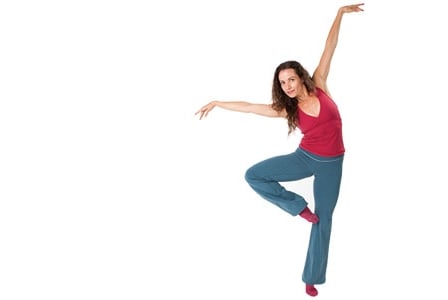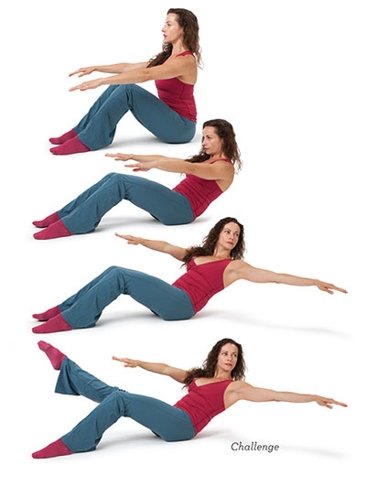
It\’s never too late to develop your inner ballerina! These simple barre exercises combine the grace and flexibility of ballet with roots in yoga and Pilates.
With roots in ballet, yoga and Pilates, barre exercises are exploding in popularity. Through controlled, precise movements using a ballet barre and other props, these workouts promise a strong core and long, lean muscles. So belly (and bums and thighs) up to the barre!
History of barre workouts
Fitness trends come and go like fashion: some are too ridiculous to last a season, while others become beloved classics. When it comes to barre-based fitness programs, however, what looks like an overnight success has been decades in the making.
It all started with Lotte Berk, a ballet dancer who developed a series of strengthening and rehabilitation exercises. Berk built a celebrity clientele at her studio in the 1960s, and her program gained an even greater following when it arrived in America in the ’70s.
Today, there are a number of studios around Australia offering instruction evolved from Berk’s teachings. While their approaches and philosophies may differ, what they all have in common are exercises drawn from the disciplines of ballet, Pilates, yoga and even physical therapy, and based on precise, controlled movements.
These workouts have long been popular in California and New York, where the rich and famous—and those who wish they were—road test the latest ways to build the body beautiful. But with the workout’s growing popularity, we mere mortals can now experience this low-impact exercise program.
What are the workouts like?
Classes for barre-based fitness are generally small: usually between 10 and 20 students work with one instructor, so each participant can expect some personal attention. If you’ve never taken a dance class, don’t worry—although there are exercises and postural cues from ballet, this is a conditioning workout, not a choreographed one.
The exercises include small, controlled movements called “pulses” that work into the supporting or stabilising muscles of the body, thereby challenging balance, elevating the heart rate and delivering increased muscular strength and flexibility. The resulting physique is what aficionados refer to as the coveted “dancer’s body.” The focus is on perfecting your form and those small holding and pulsing movements.
After a warm-up and some upper body work, a class usually heads to the barre for a series of standing exercises that includes squats with various foot positions, leg lifts and stretching. These can be deceptively challenging, so don’t be surprised if your legs feel a bit like overcooked spaghetti for the first few sessions.
Next, expect some seated abdominal work and mat work, all with the goal of achieving the holy grail of barre-based workouts: a higher, firmer backside.
Finally, a quick stretch soothes trembling limbs and ensures that students will leave feeling tall, lifted and centred.
Is a barre workout right for you?
A barre workout might be perfect for you if you
- enjoy the motivation of a group fitness class
- want direction, clear verbal cueing and personal attention to form
- prefer a quiet, focused workout without a lot of chatting
- need a time-efficient program (you’ll get a lot done in an hour—weights, core strengthening, stretching—while keeping the heart rate high)
- crave consistency (while there are many exercises and variations, the basic class format remains the same)
How to prepare for a barre workout class
Use a locker, if provided
Your space at the barre is relatively small, and you don’t want anything larger than a water bottle getting in the way.
Remember your ankle socks
Some studios are carpeted and socks are mandatory. Others have hardwood floors and socks are optional, but having them is never a bad idea.
Keep it tight
Form-fitting clothing enables instructors to see your body and help correct your positioning. A longer pant or legging means your skin won’t stick or slide on the barre.
Weights, straps and all other equipment is usually provided
To set something up for a new move, just follow the others and your instructor will assist you as needed.
Come to class early, especially your first time
You can meet your instructor, ask questions and let your trainer know about any injuries or concerns you might have.
Barre basics workout
Here is a basic barre workout you can do at home, courtesy of barre workout instructor Ella Jotie. You’ll need a sturdy chair or kitchen bench in place of a traditional ballet barre.
Remember to always keep your barre posture engaged (ears, shoulders and hips aligned with the spine long and the core engaged). Do this workout three times per week and work your way up to five times per week.
Push-ups

Works: upper body (chest, arms, back) and core
- Begin on the ground in plank position, with palms on the ground in line with your chest and wider than your shoulders. Pull the navel towards the spine and keep the spine and neck aligned.
- Keep the body in one line as you lower towards the ground and push back up.
Reps: Do 8 push-ups and then hold halfway for 8 counts. Work your way up to 16 push-ups and then hold halfway for 16 counts.
Challenge: lift one leg off the floor
Standing Barre Butt Work

Works: the bum (glutes and hamstrings)
- Stand facing a benchtop or chair back, in barre posture—ears, shoulder, hips and knees aligned, feet hip-distance apart in parallel, pulling the navel in towards the spine. Resting your hands on the bench or chair back, lean forwards slightly so your weight is on the balls of your feet, keeping your alignment straight.
- Extend your right leg behind you, keeping the toe pointed and on the floor, and the leg straight.
- Squeeze your glute muscle and lift the toe off the floor 2.5 cm and lower 16 times, followed by 32 pulses with your foot in the air behind you.
Reps: Repeat 3 times. Switch legs.
Challenge: release one or both hands overhead
Plié

Works: thighs
- Begin by standing facing a benchtop or back of a sturdy chair with your heels together and toes apart (ballet’s first position). Place your hands on the bench or chair for support and balance.
- Lift heels 7.5 cm off the floor and keep them firmly together as you lower your body a few inches towards the heels, bending at the knees. Repeat 16 times.
- Pulse when you’re at the lowest part of your plié, by lowering 2.5 cm and raising 2.5 cm. Keep the quads engaged and knees bent, tracking over the centre of the feet. Repeat pulse 32 times.
Reps: Repeat 3 times.
Challenge: release one or both hands overhead
C-Curve Twists

Works: core
- Begin seated on the floor with feet flat, knees pointing towards the sky. Sit tall on the sit bones and reach arms straight out in front of the body.
- Exhale as you tuck the tailbone and curl the spine forwards halfway to the floor (creating a C-curve with the body).
- Engage the core and pull the navel to the spine. Hold.
- Open the right arm in line with your right shoulder as you gently twist to the right from the centre of the body.
- Return to centre and repeat 16 times.
- Hold, and then pulse 32 times on the right.
Reps: Repeat entire sequence to the left.
Challenge: as you twist, extend your opposite leg in front of you, slightly off the floor
What’s a pulse?
A pulse is a very small, controlled movement, usually only 2.5 cm, that’s repeated a specified number of times to really work the muscles. If you’re new to barre exercise, modify the number of pulses specified in these exercises, or do as many pulses as you can and increase as you become stronger.
With roots in ballet, yoga, and Pilates, barre exercises are exploding in popularity across North America. Through controlled, precise movements using a ballet barre and other props, these workouts promise a strong core and long, lean muscles. So belly (and buns and thighs) up to the barre!
